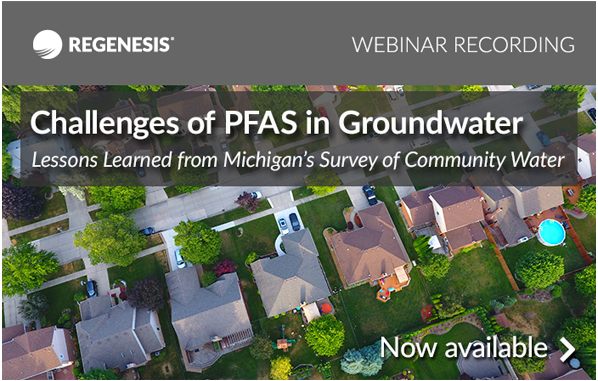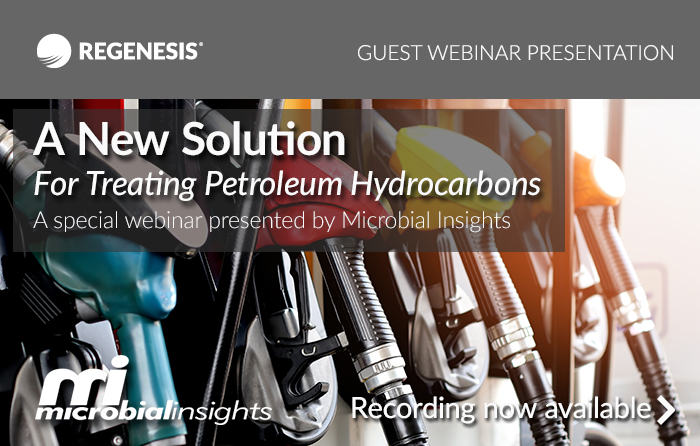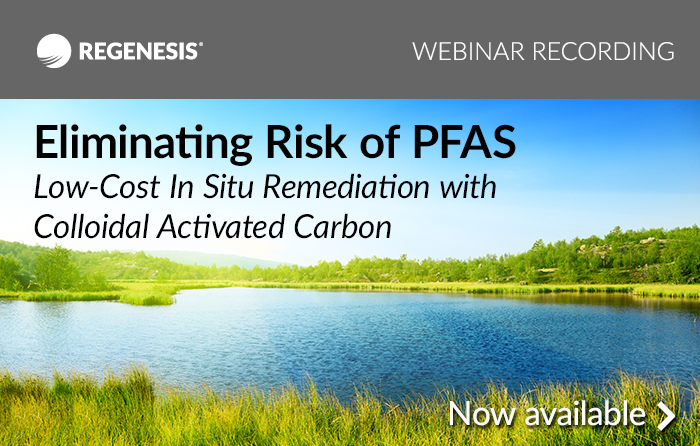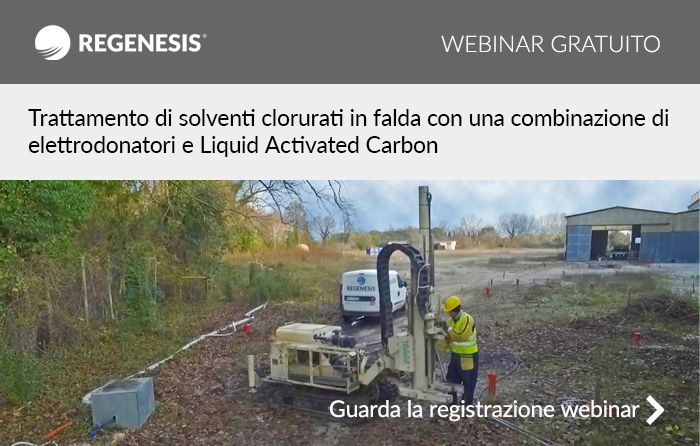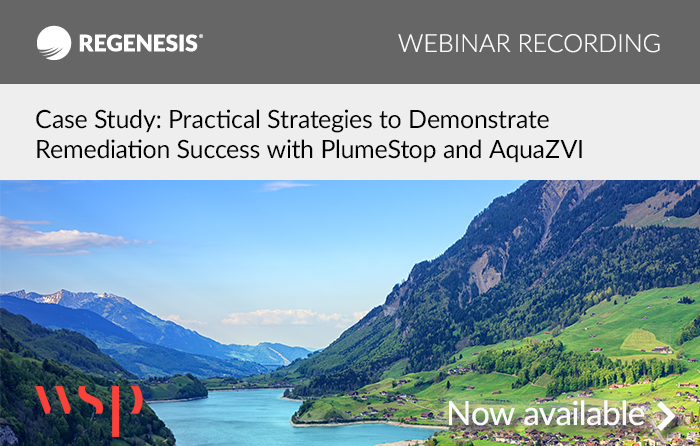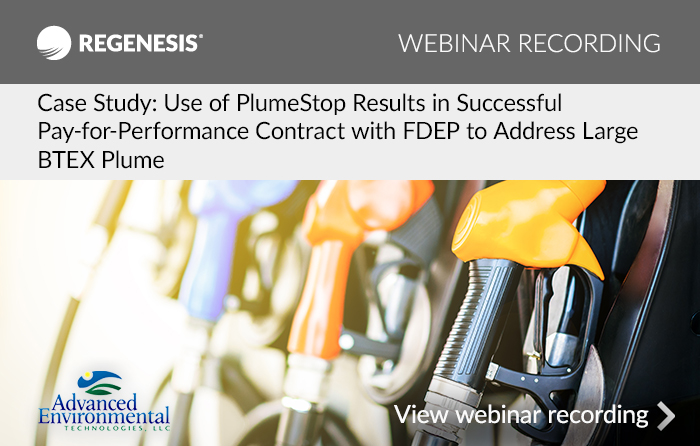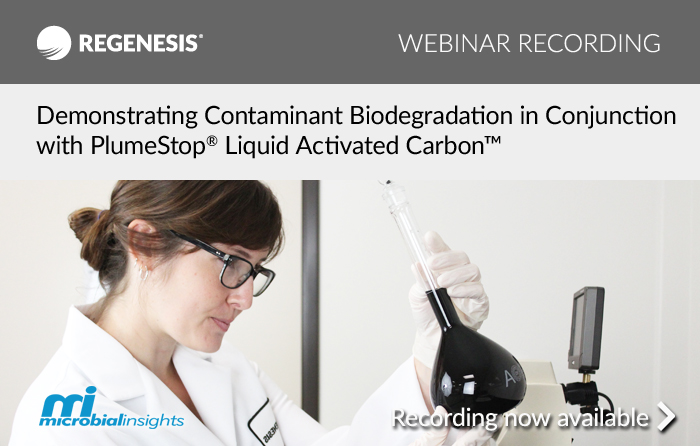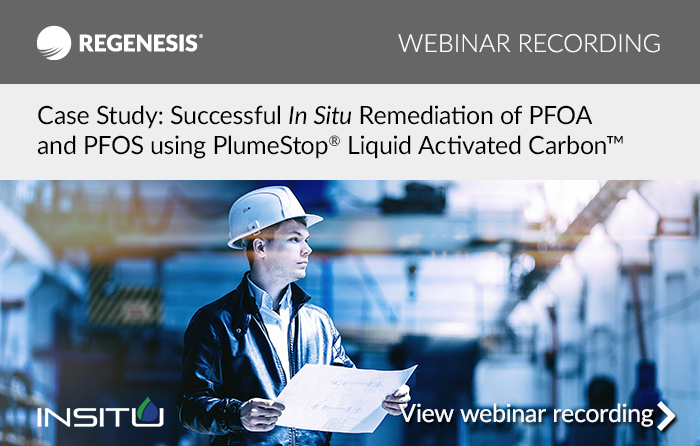Challenges of PFAS in Groundwater: Lessons Learned from Michigan’s Survey of Community Water
In this webinar we are pleased to have a special guest presentation by Steve Sliver of Michigan Department of Environmental Quality. Mr. Sliver will discuss challenges of PFAS in groundwater and lessons learned from Michigan’s survey of community water. Mr. Sliver is joined by Patricia Byrnes Lyman, Investigation/Remediation Manager at Michigan Dept of Military and Veterans Affairs, and Ryan Moore, Great Lakes District Manager at REGENESIS.
Learn the following in this free webinar:
- Discovery of unacceptable levels of emerging contaminants like per- and polyfluoroalkyl substances (PFAS) in a community water supply
- Immediate and longer-term actions to protect public health and ensure a reliable supply of safe drinking water
- Lessons learned during Michigan’s survey of all its community water supplies in 2018
View this free webinar
Performance of a New Activated Carbon Amendment for Bio-Remediating Petroleum Impacted Sites
In this webinar presented by Microbial Insights, Todd Herrington and Paul Erickson PhD from REGENESIS will discuss PetroFix® Remediation Fluid. This activated carbon remediation technology is easily injected in situ under low pressure, distributes in the subsurface without fracturing, and includes electron acceptors to stimulate biodegradation of petroleum contaminants in soil and groundwater.
Learn the following in this free webinar:
- A complete overview of how the PetroFix technology works to adsorb and biodegrade petroleum hydrocarbons
- How PetroFix is easily injected under low pressure and distributes in the subsurface without fracturing
- How remediation practitioners can create their own designs using the online Design Assistant
- Field case study of PetroFix successfully treating groundwater contaminants at a petroleum bulk storage facility
- Multiple lines of evidence used to evaluate remedial performance
View this free webinar
Eliminating Risk of PFAS Contamination: Low-Cost In Situ Remediation with Colloidal Activated Carbon
In this webinar we are pleased to have a special presentation by Scott Wilson, President & CEO of REGENESIS. In this presentation he discusses eliminating risk of PFAS contamination in soil and groundwater via low-cost in situ remediation with colloidal activated carbon. By coating flux zones of an aquifer with colloidal activated carbon, a permeable sorption barrier is created in situ, purifying groundwater as it passively migrates.
View the recording of this free webinar
Trattamento di solventi clorurati in falda con una combinazione di elettrodonatori e Liquid Activated Carbon
Questo webinar è stato presentato in diretta il 12 luglio 2017. L’Ing. Marcello Carboni e l’Ing. Paola Goria hanno presentato un caso di studio italiano relativo ad un sito complesso di grandi dimensioni con una contaminazione da solventi clorurati nell’acquifero superficiale. Il progetto è stato modulato per fasi, di cui la prima è consistita in un intervento di biodegradazione anaerobica potenziata mediante l’utilizzo di elettrodonatori con caratteristiche differenti tra loro (3-D Microemulsion® e prodotti della famiglia HRC®) in funzione delle diverse condizioni delle aree di trattamento. La seconda fase, di cui è stata realizzata una prova pilota in campo e il cui intervento full scale è attualmente in fase di definizione, consiste in un processo di adsorbimento in situ mediante l’innovativo PlumeStop® Liquid Activated Carbon™, finalizzato al raggiungimento di CSC particolarmente restrittive sul confine di proprietà.
Guarda la registrazione webinar
Case Study: Practical Strategies to Demonstrate Remediation Success with PlumeStop and AquaZVI
Stimulating biodegradation of chlorinated VOCs on activated carbon and direct abiotic treatment of using reduced metals such as ZVI are not new to the remediation industry and have proven to be highly effective when direct contact is made. However, the colloidal solid composition of these materials severely limits efficient in situ application at most sites. The steric stabilization chemistry behind the REGENESIS products PlumeStop and AquaZVI eases delivery challenges and dramatically widens the applicability window of these amendments to include most sites where in situ remediation is contemplated.
In this webinar we are pleased to have as a special guest speaker Matthew Burns, Technical Fellow and the U.S. contaminated land national service line director for WSP. He presents PlumeStop and AquaZVI treatment case studies and practical analytical strategies used to demonstrate destructive treatment of groundwater contaminants.
View the recording of this free webinar
Caso di studio: Contenimento in situ di PFAS mediante PlumeStop Liquid Activated Carbon
In questo webinar Marcello Carboni, Mediterranean District Manager di REGENESIS, discuterà della capacità del PlumeStop® Liquid Activated Carbon di trattare in modo vantaggioso i composti perfluorurati (PFAS), compresi PFOS e PFOA. Introdurrà le caratteristiche di questi contaminanti complessi, illustrerà come il PlumeStop adsorbe in situ i PFAS, discuterà le strategie di contenimento di plume di perfluorurati mediante barriere di iniezione, e presenterà un caso studio di un sito contaminato da PFAS in Canada che è stato bonificato con successo utilizzando il PlumeStop.
Questo sito, un ex stabilimento industriale di produzione di mobili in cui era presente anche una struttura di addestramento antincendio, era in corso di trattamento per la presenza residuale di idrocarburi petroliferi quando delle ulteriori analisi sulle acque sotterranee hanno indicato la presenza in falda anche di PFOA e PFOS. Utilizzando la metodologia direct push, il PlumeStop è stato iniettato insieme all’ORC Advanced® in 50 postazioni nell’acquifero in sabbia limosa al fine di trattare gli idrocarburi petroliferi. Le analisi di monitoraggio post-iniezione su un arco temporale di 18 mesi hanno evidenziato che sia gli idrocarburi petroliferi che PFOA e PFOS sono scesi al di sotto dei limiti di rilevabilità strumentale. Sarà inoltre discusso un sito italiano contaminato da PFAS, dove sono attualmente in corso test batch e in colonna prima di procedere ad un’applicazione pilota in campo.
Presentato da: Marcello Carboni
View webinar recording:
Case Study: Use of PlumeStop Results in Successful Pay-for-Performance Contract with FDEP to Address Large BTEX Plume
First broadcast: April 26, 2018
Speakers: Gordon Dean, Vice President of Advanced Environmental Technologies (AET)
In this webinar we are pleased to have as a special guest speaker Gordon Dean, Vice President of Advanced Environmental Technologies, LLC (AET). His presentation discusses a project where Mr. Dean designed a remedial approach employing PlumeStop®, RegenOx® and ORC Advanced® to sorb, degrade and destroy an existing petroleum contaminant plume. Because Mr. Dean’s remediation solution leveraged a combined remedy featuring PlumeStop, the project was awarded a pay-for-performance contract with the Florida Department of Environmental Protection (FDEP).
View the recording of this free webinar
Case study: Successful in situ remediation of PFAS using PlumeStop – with Rick McGregor of ISRL
Recording Available | In this webinar we are pleased to have as a special guest speaker Rick McGregor, President of InSitu Remediation Services Ltd. His presentation discusses the in situ remediation of PFOA and PFOS at a site in eastern Canada using PlumeStop® Liquid Activated Carbon™.
This site, a former industrial furniture manufacturing site where a fire training facility was co-located, was being remediated for residue petroleum hydrocarbons when groundwater testing indicated that PFOA and PFOS was present within the groundwater. Using direct push technology, Liquid Activated Carbon along with ORC Advanced® was injected at 50 locations within the silty sand aquifer to address the petroleum hydrocarbons. Post-injection testing over a one-year period indicated that the petroleum hydrocarbons along with the PFOA and PFOS was attenuated to below the applicable method detection limits.
View webinar recording
Demonstrating Contaminant Biodegradation in Conjunction with PlumeStop®Liquid Activated Carbon™
First broadcast: July 25, 2017
Speakers: Dora Taggart President, Microbial Insights, Inc.
Recording Available | PlumeStop Liquid Activated Carbon is an innovative remediation technology with the potential to rapidly reduce dissolved contaminant concentrations, decrease risk of migration, and provide a means of addressing contaminant back-diffusion. As is demonstrated in this webinar, the technology permits and promotes biodegradation to achieve not just containment but effective contaminant destruction as a long term solution.
In this webinar we are pleased to have as a special guest speaker Dora Taggart, President of Microbial Insights, Inc. Her presentation focused on case studies where molecular biological tools (qPCR and QuantArray®) were used to investigate the impact of PlumeStop injections on key halorespiring bacteria and anaerobic biodegradation at chlorinated solvent sites. The full recording is now available here.
View webinar recording
Case Study: Successful In Situ Remediation of PFOA and PFOS using PlumeStop Liquid Activated Carbon
First broadcast: December 07, 2017
Speakers: Rick McGregor President, InSitu Remediation Services Ltd and Maureen Dooley, Director of Strategic Projects, REGENESIS
In this webinar we are pleased to have as a special guest speaker Rick McGregor, President of InSitu Remediation Services Ltd. His presentation discusses the in situ remediation of PFOA and PFOS at a site in eastern Canada using PlumeStop® Liquid Activated Carbon™.
This site, a former industrial furniture manufacturing site where a fire training facility was co-located, was being remediated for residue petroleum hydrocarbons when groundwater testing indicated that PFOA and PFOS was present within the groundwater. Using direct push technology, Liquid Activated Carbon along with ORC Advanced® was injected at 50 locations within the silty sand aquifer to address the petroleum hydrocarbons. Post-injection testing over an one-year period indicated that the petroleum hydrocarbons along with the PFOA and PFOS was attenuated to below the applicable method detection limits.

 Americas
Americas Europe
Europe Français
Français Deutsch
Deutsch Italiano
Italiano Español
Español